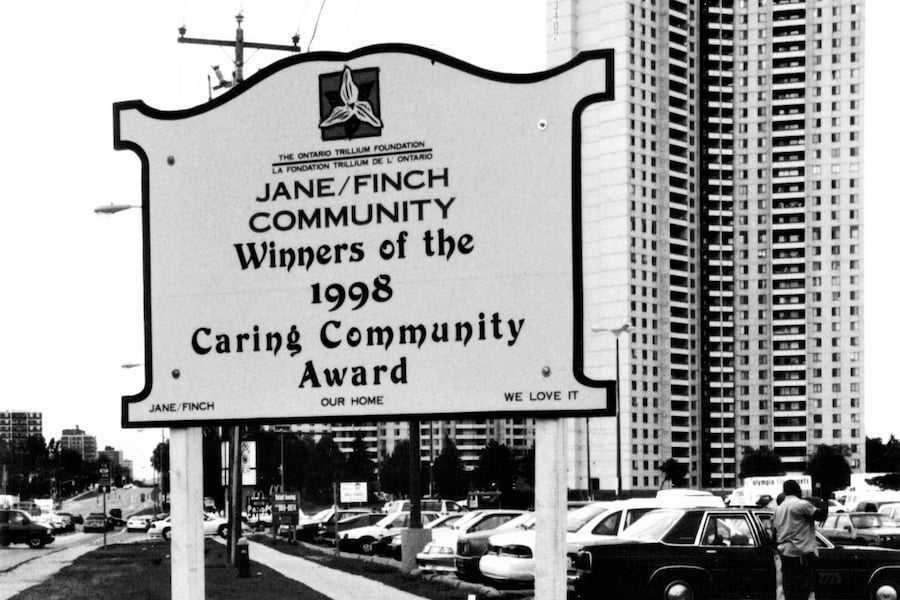

The 1970s was a busy decade. The Downsview Weston Action Community (DWAC) was playing a significant role in developing community-based organizations with passionate and committed leaders to address the lack of social infrastructure neglected by the city planners and elected officials. One priority for DWAC was to meet the needs of families with young children, a group assumed to be frequently isolated.
Resident Helen Ede also had an interest in this area and agreed to chair a committee with a mix of residents and professionals to explore the idea of a multi-service centre. When asked about her volunteer work in this area, she said, “I joined a committee to put their work on a stronger footing. Community input was scant because most people were simply confused, as I was, about what we were attempting. We could only look to the past for models. Hull House (Chicago), and settlement houses and similar agencies provided models we could modify to suit a suburban situation. A location for a centre like downtown centres was out of the question.”
As part of that exploration, Ede researched models that existed in the United States, England and Australia. As a result of her research, the group began to think about a place that would have three components of service: a centre for parents and children, a community office, and community outreach. Those recommendations were informed by the committee members’ visits to existing sites in Toronto – the Children’s Storefront (for the Child/Parent Centre), Don Vale Secretariat (for the Community Office) and St. Christopher House (for Community Outreach). While these were the initial services to be delivered, other services and programs were also investigated.
Ede said, “Some other components were set aside due to lack of expertise, time, and cost. These included a music component (the schools provided music) and a community credit union. The practicalities took much time and energy. These included drawing up a constitution, applying for Letters Patent and incorporation, getting a non-profit status, organizing an interim board of directors, and the time-consuming process of applying for grants and looking for space.”
Recognizing that such a centre needed to expand its support base, a letter was sent to the Social Planning Council of Metro Toronto (SPC) to ask for assistance to help formulate an approach to developing the centre.
The SPC executive director gave the letter to two of the planners and asked that one respond. Marvyn Novick, who later played a significant role in exposing the depth of poverty in the suburbs, tells this story of how they decided who should check out this organization.
“I was working at the Social Planning Council and in a staff meeting we were advised that a request had come from a group in the Jane-Finch community for somebody from the professional staff to come out to do some consulting with the community. I was chair of the social development group. I had people working with me. The guy who was doing a lot of the consulting was a guy named Doug Barr, who became a trustee and chair of the Toronto School Board and head of the Canadian Cancer Society. But at that time, he was in my unit, and we were confirmed parochials [sic] – provincials from downtown Toronto. The whole debate was about who was going to respond to this request because neither of us wanted to. The agreement between Doug Barr and me was that we would flip a coin and whoever ‘lost’ would go up to Jane-Finch and consult. I lost the coin toss, and I was the one who went out to Jane-Finch. It was one of the best losses in my life. Had I won the coin toss, my whole professional life would have changed. Doug Barr would have gone to Jane-Finch.”
He went on to say, “Downtown Toronto was where all the exciting things were happening with wise young people who were into new ways of living. We were on the cutting edge of urban life. […] Why would anybody want to go up to Jane-Finch?”
Mary Lewis used to do some work with SPC and given that she was already connected to Jane-Finch and knew Marvyn, she followed up with a phone call. “Marvyn, you really have to come and see what’s happening in Jane-Finch – could I pick you up one morning and take you there, and we’ll do a tour?” Lewis took him on a tour around all the different neighbourhoods and emphasized that there was a role for Social Planning Council to play. Marvyn agreed and so the DWAC sub-committee met with Novick to discuss what was needed in terms of a resource centre and to ask for his advice and suggestions.
Novick remembered his first impressions: “As soon as I came into the community, it dawned on me that there was a world of people in the Jane-Finch community who were basically forgotten. Nobody knew about them. But they were quite committed to their area, and they were every bit as committed as people in the Annex, people in the Beach, people in Regent Park. We didn’t know about them though; nobody knew about them at all. They were just ‘up there’ and forgotten. There was a lot of learning.”
Excerpted from By Us! For Us! Activism In Jane-Finch, A Working Class Community, by Wanda MacNevin, published by FriesenPress (444 pages). Book launch takes place Wednesday, June 8 at 6:30 pm, at Brookview Middle School (4505 Jane). The author plus guests will be speaking, and books will be available for sale for $30. More info at byusforus-janefinch.ca












